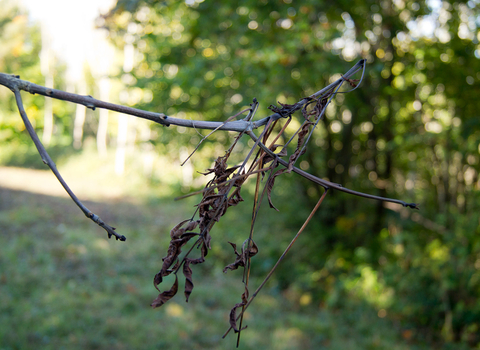A fatal fungal disease of Ash trees
First confirmed in the UK in 2012, Ash Dieback, also known as 'Chalara' or Chalara Ash Dieback, is an incurable disease of Ash trees caused by a fungus called Hymenoscyphus fraxineus.
Ash dieback has already caused the widespread loss of Ash trees in continental Europe and is now affecting woodland throughout the UK. Surveys across Trust-owned sites or those where we are responsible for woodland management have identified extensive numbers of Ash trees infected by the disease.
Falling branches can be a serious risk to people and property. As such, the Trust has determined that the selective felling of Ash trees which pose the greatest risk to public safety is the most appropriate course of action - an approach widely adopted by other organisations and agencies in the UK, including Local Authorities, as best practice for managing the impact of the disease.
For further information about Ash Dieback and how we manage sites impacted by the disease, please see below.
Ash Dieback symptoms
The disease causes Ash trees to die
Young Ash trees die quickly, whilst mature trees can be killed by a yearly cycle of repeated infection. Diseased trees may also get honey fungus, causing branches or whole trees to collapse.
The main symptoms of Ash Dieback are:
- Blackening of leaves which often hang on the tree
- Discoloured stems, often with a diamond-shape lesion
- Black and shrivelled shoots
- The death of twigs and branches in the crown of mature trees
- Small white fruiting fungal bodies on blackened stalks in early autumn
Ash Dieback FAQ
What is Ash dieback disease?
First discovered in the UK in 2012, Ash Dieback is a fungal disease affecting Ash trees. The disease is now present in all counties of England. The results of the disease in mainland Europe suggest that the majority of Ash trees in woodlands infected with the disease will decline and die.
How widespread is Ash dieback disease in Surrey?
It is estimated that 80% of Ash trees could be lost to the disease nationally. Surveys across Trust owned or managed sites in Surrey have identified extensive areas of Ash trees which are infected by the disease.
What action are we taking?
The Trust has carried out a review of the woodlands we manage in line with Ash dieback guidance from the Forestry Commission and the National Tree Safety Group.
In order to protect site visitors we carry out selective felling of Ash trees which pose a threat to public on Trust owned sites, or sites where we are responsible for woodland management. These may include trees located in proximity to permissive footpaths, bridleways, roads, car parks and boundaries of neighbouring properties.
On Trust managed sites where we are not responsible for woodland management, the landowner is responsible for the monitoring of Ash Dieback and any tree safety works. In these instances the Trust may advise on appropriate mitigation actions where appropriate.
Which reserves are affected?
All Surrey Wildlife Trust managed or owned sites with Ash trees are likely to be affected by the disease.
What impact does this have on wildlife?
Wherever possible, the felling of affected trees takes during winter, when many species are dormant or absent and outside of bird nesting season. This minimises the impact on the environment and wildlife.
Ecological surveys are carried out on all areas identified for selective felling to ensure the appropriate methodology and mitigation measures are followed. Where appropriate the Trust also liaises with interested parties including bat, Badger, butterfly, Dormouse and botanical groups.
Opening rides and glades brings more light to the forest floor, so we may see more butterflies, orchids and other species benefitting longer term.
Will the trees be replaced?
The woodlands is left to regenerate naturally with a range of tree species including, hopefully, some disease tolerant Ash trees. If this does not happen, the area will be considered for restocking with an alternative native species. Progress is reviewed on an ongoing basis.
Those Ash saplings that are not resistant to the disease will die within a few years and do not pose a safety risk due to their small size.
More about Ash Dieback
Find out more about Ash Dieback on the Forestry Commission website






